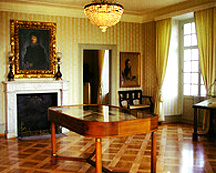
Scenic Trains
Glacier
Express
Bernina
Express
Golden
Pass Line
Wilhelm
Tell Express
Mont
Blanc - St Bernard
Palm
Express
Excursion Trains
Jungfraujoch
Chocolate
Train
Gornergrat
Matterhorn
Mt
Rigi Railway
Roches
De Naye
Lucerne Attractions
Lake
Lucerne Cruises
Mt
Pilatus Rail-Aerial
Transport
Museum
Rosengart
Collection
Glacier
Garden
Bourbaki
Panorama
Wagner
Museum
Chronoswiss
Workshop
![]()
LUCERNE ATTRACTIONS
RICHARD WAGNER MUSEUM - LUCERNE
 Richard Wagner, known for his bombastic
operas of Norse Gods and winged Valkyries, spent several years of his
life in Switzerland on the shores of lake Lucerne. Wagner was born
in Leipzig, went to grammar school in Dresden, returned to Leipzig's Old Nicolas School, and served as a choirmaster
in Würzburg, and his operas were performed on the stages of Paris.
Becoming involved in nationalist politics his home region of Saxony
he had beat a hasty departure after the failed “May Uprising” against
the Hohenzollern King Frederick Augustus. The Wittenberg King Ludwig
II of Bavaria, the builder of romantic revival castles was a huge fan
of
Wagner and
offered
him
sanctuary
in Munich. But Wagner’s personal life became even more complicated
there, through a scandalous affair with the married daughter of his
friend Franz Lizst. So “Mad” King Ludwig footed the bill
for Wagner to take up a residence in Lucerne.
Richard Wagner, known for his bombastic
operas of Norse Gods and winged Valkyries, spent several years of his
life in Switzerland on the shores of lake Lucerne. Wagner was born
in Leipzig, went to grammar school in Dresden, returned to Leipzig's Old Nicolas School, and served as a choirmaster
in Würzburg, and his operas were performed on the stages of Paris.
Becoming involved in nationalist politics his home region of Saxony
he had beat a hasty departure after the failed “May Uprising” against
the Hohenzollern King Frederick Augustus. The Wittenberg King Ludwig
II of Bavaria, the builder of romantic revival castles was a huge fan
of
Wagner and
offered
him
sanctuary
in Munich. But Wagner’s personal life became even more complicated
there, through a scandalous affair with the married daughter of his
friend Franz Lizst. So “Mad” King Ludwig footed the bill
for Wagner to take up a residence in Lucerne.
From 1866 to 1872, Wagner lived in an 18th Century mansion in Tribschen, just overlooking the lake, south of the city. He referred to his six years on the lakeside his “Tribschen idyll”. There, he married his mistress Cosima Liszt von Bülow, had a couple of children and presented her with a composition for her birthday in 1870, the “Siegfried Idyll”, ori8ginall performed on the stairway of the house. His Ring Cycle of operas were in good parts composed during his Switzerland years, rather inspired from his climb up nearby Mt Pilatus. The mountains of Germany, weren’t nearly as suggestive of the God’s Valhalla as the snow-capped peak, where the body of Pontious Pilate was said to be buried deep in an ice lake. Wagner left the Tribschen house in 1872, moving to Bayreuth to establish his festival opera theater.
The house contains some memorabilia from Wagner’s time there, displayed on the lower floor, most singularly the Grand Piano upon which Wagner composed “Die Meistersinger von Nurnberg”. Also there are photographs and paintings relating to Wagner’s life and work, and a collection of letters and musical scores. On the upper floor is the Schumacher Musical Instrument Collection of historic musical instruments. The Richard Wagner Museum is open Tuesday to Sunday 10 am to 12 pm and 2 pm to 5 pm, from mid-March thru November. There is a park if the museum is closed. The museum can be reached by city bus line 6, 7 or 8 to the Wartegg stop, about 20 minutes from the Lucerne Bahnhof. Visit by Lake Lucerne ferry boat from April to October.
Find best travel and hotel deals in Lucerne on TripAdvisor
